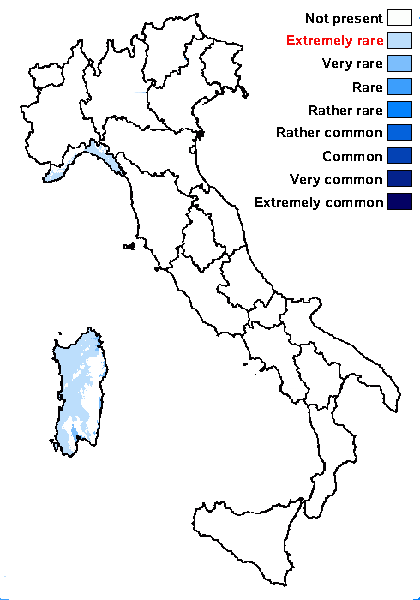Buellia imshaugii Hafellner
Beih. Nova Hedwigia, 62: 58, 1979.
Synonyms:
Distribution: N - Lig. C - Sar.
Description: Thallus crustose, episubstratic, areolate, grey to greyish brown, developing on the thalli of Dimelaena oreina. Epinecral layer 15-30 μm thick; cortex paraplectenchymatous, 30-60 μm thick, with abundant small crystals dissolving in K (yellow solution: atranorin); medulla white, I-. Apothecia lecideine, black, 0.2-0.7(-0.8) mm acrosss, adnate to sessile and constricted at base, with a flat to convex disc and a prominent, finally excluded proper margin. Proper exciple dark brown, N-, with crystals reacting P+ orange, Dispersa-type, of radially arranged hyphae, the inner part of long-celled, parallel, strongly agglutinated and thick-walled hyphae, the outer part of short-celled, isodiametric hyphae without intercellular spaces; epithecium dark brown, N-; hymenium colourless, without oil droplets, 80-100(-150) μm high; hypothecium dark brown, up to 150 μm high. Asci (6-)8-spored, clavate to cylindrical-clavate, the apical dome K/I+ dark blue with a pale, conical-pointed apical cushion (axial mass), the wall I-, but the thin outer gel I+ blue, Bacidia-type. Ascospores 1-septate, brown, ellipsoid, 12-16 x 6.5-7.5 μm, Physconia-type when young, Buellia-type when mature, the wall microrugulate. Pycnidia black, semi-immersed in the thallus. Conidia bacilliform, 5-7 x c. 1 μm. Photobiont chlorococcoid. Spot tests: cortex K+ yellow; medulla C-, KC-, P+ orange. Chemistry: atranorin (major) medulla with pannarin.Note: a xeric subtropical lichen of hard siliceous rocks, starting the life-cycle on Dimelaena oreina; described from North America, but also reported from Mediterranean Europe; the identity of the European material, however, is dubious, as the species may have been confused with specimens of Tetramelas concinnus associated with Dimelaena (see Giralt & Elix 2010).
Growth form: Crustose
Substrata: rocks
Photobiont: green algae other than Trentepohlia
Reproductive strategy: mainly sexual
Subcontinental: restricted to areas with a dry-subcontinental climate (e.g. dry Alpine valleys, parts of Mediterranean Italy)
paras Dimelaena oreina
Commonnes-rarity: (info)
Alpine belt: absent
Subalpine belt: absent
Oromediterranean belt: absent
Montane belt: absent
Submediterranean belt: absent
Padanian area: absent
Humid submediterranean belt: extremely rare
Humid mediterranean belt: extremely rare
Dry mediterranean belt: very rare

Predictive model
Growth form: Crustose
Substrata: rocks
Photobiont: green algae other than Trentepohlia
Reproductive strategy: mainly sexual
Subcontinental: restricted to areas with a dry-subcontinental climate (e.g. dry Alpine valleys, parts of Mediterranean Italy)
paras Dimelaena oreina
Commonnes-rarity: (info)
Alpine belt: absent
Subalpine belt: absent
Oromediterranean belt: absent
Montane belt: absent
Submediterranean belt: absent
Padanian area: absent
Humid submediterranean belt: extremely rare
Humid mediterranean belt: extremely rare
Dry mediterranean belt: very rare

Predictive model
 INDEX FUNGORUM
INDEX FUNGORUM
 GBIF
GBIF

